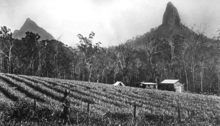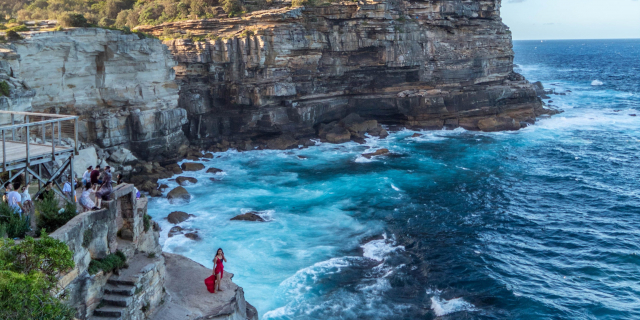The Sunshine Coast is a peri-urban region in South East Queensland, Australia. It is the district defined in 1967 as "the area contained in the Shires of Landsborough, Maroochy and Noosa, but excluding Bribie Island". Located 100 km (62 mi) north of the centre of Brisbane in South East Queensland, on the Coral Sea coastline, its urban area spans approximately 60 km (37 mi) of coastline and hinterland from Pelican Waters to Tewantin.
The area has several coastal hubs at Caloundra, Kawana Waters, Maroochydore and Noosa Heads. Nambour and Maleny have developed as primary commercial centres for the hinterland.
Since 2014, the Sunshine Coast district has been split into two local government areas, the Sunshine Coast Region and the Shire of Noosa, which administer the southern and northern parts of the Sunshine Coast respectively.
As of June 2021, with an estimated urban population of 398,840, the Sunshine Coast is the fifth most ...Read more
The Sunshine Coast is a peri-urban region in South East Queensland, Australia. It is the district defined in 1967 as "the area contained in the Shires of Landsborough, Maroochy and Noosa, but excluding Bribie Island". Located 100 km (62 mi) north of the centre of Brisbane in South East Queensland, on the Coral Sea coastline, its urban area spans approximately 60 km (37 mi) of coastline and hinterland from Pelican Waters to Tewantin.
The area has several coastal hubs at Caloundra, Kawana Waters, Maroochydore and Noosa Heads. Nambour and Maleny have developed as primary commercial centres for the hinterland.
Since 2014, the Sunshine Coast district has been split into two local government areas, the Sunshine Coast Region and the Shire of Noosa, which administer the southern and northern parts of the Sunshine Coast respectively.
As of June 2021, with an estimated urban population of 398,840, the Sunshine Coast is the fifth most populated area in Queensland and the 9th most populous in the country. The population of the area has grown steadily at an average annual rate of 2.4% year-on-year over the five years to 2018.
 Aerial vista of the University of the Sunshine Coast and its surrounds in 2023.
Aerial vista of the University of the Sunshine Coast and its surrounds in 2023.The earliest residents of the Sunshine Coast were the indigenous Gubbi Gubbi and Wakka Wakka people.[1] The territory of the Kabi includes about 21,000 square kilometres (8,200 sq mi) along the coastline from the 27th parallel northward to the mouth of the Burrum River.[1] The country of the Wakka Wakka people was about 13,000 km2 (5,000 sq mi) that was roughly triangular to the west of the Kabi, including a small part of the Dawson,[clarification needed] and meeting the northern Kabi boundary at Walla.[clarification needed] The two tribes were friendly and intermarried and had the same class restrictions.[1][page needed] The groups were nomadic, gathering food en-route as they moved from one campsite to the next.[1]
Gubbi Gubbi (Kabi Kabi, Cabbee, Carbi, Gabi Gabi) is an Australian Aboriginal language spoken on Gubbi Gubbi country. The Gubbi Gubbi language region includes the landscape within the local government boundaries of the Sunshine Coast Region and Gympie Region, particularly the towns of Caloundra, Noosa Heads, Gympie and extending north towards Maryborough and south to Caboolture.[2]
 Log rafting on the Noosa River, 1889
Log rafting on the Noosa River, 1889 Pineapple plantation in the 1930s
Pineapple plantation in the 1930s Mount Beerwah is part of the Glass House Mountains National Park
Mount Beerwah is part of the Glass House Mountains National ParkIn 1770, James Cook on the deck of HM Bark Endeavour became the first known European to sight the Glass House Mountains, located south-west of Caloundra.[3]
In the 1820s, former convicts John Finnegan, Thomas Pamphlett and Richard Parsons landed on Moreton Island after becoming hopelessly lost fetching cedar. They lived with the Kabi Kabi for eight months.
Thereafter, during the 1830s to 1840s, the district became home to numerous runaway convicts from the Moreton Bay (Brisbane) penal colony slightly to the south.[4]
In 1842, Governor George Gipps had the entire Sunshine Coast and hinterland from Mt Beerwah north to roughly Eumundi declared a "Bunya Bunya Reserve" for the protection of the bunya tree after Andrew Petrie advised him of the importance of bunya groves in Aboriginal culture.[5] However, during the 1840s and 1850s, the Bunya Bunya Reserve and its vicinity became the scene of some of the most bitter skirmishes of Australia's "Black War". The Blackall Range, on account of the tri-annual Bunya Festival, served as both a hideout and rallying point for attacks against white settlements. By the 1850s timber cutters and cattlemen had started exploiting the area; in 1860 the Bunya Bunya Reserve was scrapped.
Many of the Sunshine Coast's towns began as simple ports or jetties for the timber industry during the 1860s and 1870s, as the area once had magnificent stands of forest. Likewise, the region's roads often began as snigging tracks for hauling timber. Timber getters used the region's creeks, rivers and lakes as seaways to float out their logs of cedar – the resultant wood being shipped as far afield as Europe.
During the Gympie Gold Rush (1867), prospectors scaled the Sunshine Coast mountains to develop easier roadways to and from the gold fields of Gympie. After the construction of the railway line to Gympie, the coastal and river towns, being mostly ports for the early river trade, were bypassed.[6]
By the 1890s, diverse small farming (fruit and dairy) had replaced the cattle-and-timber economy of earlier decades. Sugar cane and pineapples proved especially important to produce for the district. Many small hamlets and towns now emerged. Produce was initially taken by horse to Landsborough, then to Eudlo in 1891.[7]
The post-World War I era saw the rise of the "seaside shack". The seaside shack provided the opportunity for the coastal "getaway" with modest investment. From 1914 to 1946, they popped up all along the North Coast (because it was north of Brisbane). Seaside shacks were exceedingly cheap and were an early use of the concept of recycling. Many were built of disused or second grade timber, all kinds of materials were used for the holiday seaside shack, including fibro cement, metal containers, and left-over farm sheds; even disused trams were sold off as seaside shacks.[8]
Especially after World War II, the Sunshine Coast grew into a holiday and surfing destination. This tendency was further expanded in the development boom of the 1960s and 1970s.[9]
Then known as the Near North Coast,[10][11] the renaming of the South Coast to become the Gold Coast triggered interest in renaming the Near North Coast to increase the tourist appeal. Names considered included the Silver Coast, the Diamond Coast, and Suncoast. Suncoast was rejected as it was copyrighted by a proprietary company.[12] In 1967, it was officially renamed the Sunshine Coast.[13][14]
Around the same time, various tourist attractions and theme parks were created, such as the Big Pineapple in Woombye.[15]
After the 1980s, the Sunshine Coast experienced rapid population growth. As of 2016[update] it had become one of the fastest-growing regions in Australia.[16] As the region becomes increasingly residential, most of the district's distinctive small farms – especially tropical-fruit and sugar-cane farms have disappeared, as have most of its theme parks. The Moreton sugar mills closure in 2003 removed a market for the district's 120 cane growers who had been harvesting cane in the region.[17] Instead, businesses concerned with retail, catering and tourism have assumed increasing importance.
In 2008, The Shire of Noosa, Shire of Maroochy and City of Caloundra merged to form the Sunshine Coast Region. The 2007 referendum conducted by the Australian Electoral Commission and leading to the merger remained controversial in Noosa Shire, where 95% of voters had rejected amalgamation.[18]
In March 2013, a second referendum resulted in 81% of residents voted to leave the amalgamated Sunshine Coast Region. On 9 November 2013 an election resulted in Noel Playford being elected to take office as mayor on 1 January 2014 with the new council.[19]
The Shire of Noosa was re-established on 1 January 2014. This resulted in two geopolitical areas occupying the area generally recognised as 'The Sunshine Coast'. The Sunshine Coast Region, governed by the Sunshine Coast Council and the Shire of Noosa, governed by Noosa Shire Council.
At the 2016 census,[20] the population of the Sunshine Coast was 346,522. The median age was 44 years old, 6 years older than the nationwide median. The male-to-female ratio was 48.3-to-51.7. Most residents were born in Australia (73.7%), with 1.9% being Indigenous Australians. The most common countries of birth of other residents were England (6.2%), New Zealand (4.5%), South Africa (1.0%), Germany (0.7%), and Scotland (0.6%). The most commonly spoken languages other than English were German (0.6%), and Afrikaans, Dutch, French, and Italian (0.3% each). A large proportion of Sunshine Coast residents reported no religious affiliation (34.0%). Of those who had a religious affiliation, the most frequent were: Catholic (18.2%), Anglican (16.8%), and Uniting Church (5.2%).
Australian Bureau of Statistics (ABS) data from the May 2019 Labour Force Survey indicate that around 184,200 people were employed in the Sunshine Coast region.[21] Health care and social assistance was the largest employment sector with 26,800 people, followed by construction with 26,500 people, and education and training with 21,200 people. Other important employment sectors in the region were accommodation and food services; retail trade; and professional, scientific and technical services. The agriculture, forestry and fishing sector employed 2,600 people, representing 1 per cent of the region's workforce.
The Sunshine Coast's main operating airline, Bonza was founded in 2021 to serve the southeast Queensland region.[citation needed]































Add new comment